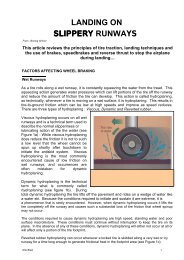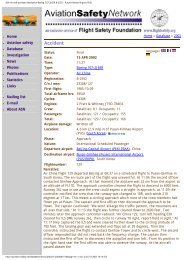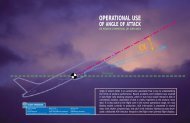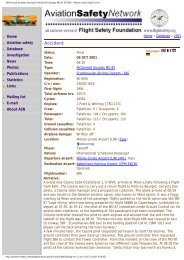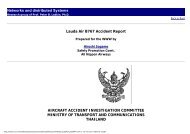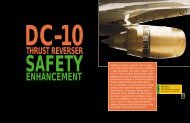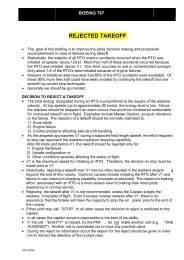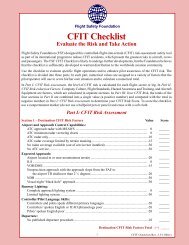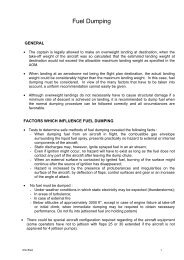Boeing 737-236 series 1, G-BGJL: Main document - Leonardo
Boeing 737-236 series 1, G-BGJL: Main document - Leonardo
Boeing 737-236 series 1, G-BGJL: Main document - Leonardo
Create successful ePaper yourself
Turn your PDF publications into a flip-book with our unique Google optimized e-Paper software.
The aircraft was fitted with 130 passenger seats, two double andone single cabin crew seats. One of<br />
the double crew seats wasforward of door L1 facing rearwards and the other double aft ofdoor L2<br />
facing forwards. In the forward passenger cabin a pairof full height galley bulkheads were<br />
positioned just aft of thetwo doors, L1 and R1. In the aft end of the cabin a full heightstowage unit<br />
was located just forward of door R2 with a singlecrew seat mounted on the rear of it, facing aft.<br />
(Appendix 3 Figsa-b)<br />
This configuration was in compliance with British Airways ConfigurationModification No 25C211,<br />
Drawing No 1-54378 certified by the BritishAirways authorised engineer as being in compliance<br />
with the appropriateregulations on the 20 November 1981.<br />
This drawing specifies a seating pitch of:<br />
Rows 1-9 Rows 9-10 Rows 10-22<br />
Pitch 30 ins 31 ins 29 ins<br />
In addition, this drawing specified that the outboard seats atrow 10, ie 10A and 10F, should be of a<br />
type modified to preventthe seat-backs from hinging forward and row 9 seats should haveno<br />
recline, in order that access to both overwing exits shouldnot be impeded.The seat backs of row 9,<br />
in common with the majorityof seats, could be folded forwards to create more room for theupper<br />
body of any person moving between rows 9 and 10 to the overwingexits. The <strong>Boeing</strong> <strong>737</strong> Type<br />
Certificate allowed the <strong>737</strong>/200 modelto be equipped with 130 passenger seats provided there was<br />
compliancewith Federal Airworthiness Regulations (FAR) 25.2(b),(c) and (d).The Emergency<br />
Evacuation requirements for this Public Transportaircraft were in accordance with FAR 25.803<br />
(Appendix 7).<br />
United Kingdom evacuation certification of this aircraft type,with 130 passenger seats, was carried<br />
out at Luton Airport onthe 26 November 1970 using a Britannia Airways <strong>Boeing</strong> <strong>737</strong>-204model.<br />
The 130 passengers and 5 crew were evacuated from the leftexits (ie aft, overwing and forward) in<br />
75 seconds.<br />
1.6.9 Emergency equipment and exits<br />
The aircraft was equipped with four main cabin doors ('Type 1')(para 1.17.6), two overwing<br />
emergency exits ('Type III') and twosliding-window emergency exits on the Flight Deck (Appendix<br />
3Fig a).<br />
Each main door incorporated a slide pack which when used in the'automatic' mode, ie with the slide<br />
'girt-bar' pre-engaged intwin floor-mounted brackets, was designed to provide automaticinflation of<br />
the slide when the door was opened in an emergency.In addition, each slide included a 'manual'<br />
release handle whichcould be used to achieve inflation if it had not occurred automatically.<br />
The overwing emergency exits were located at either side of row10 and were intended for ground<br />
evacuation of centre cabin passengers,or as the primary exits for use after a sea-ditching<br />
(Appendix3 Fig c). For the latter purpose, these exits were each equippedwith a webbing-type<br />
escape rope/lifeline, anchored to the upper/forwardcorner of the aperture, with a snap-hook on the<br />
other end forattachment to a lug located on the upper surface of each wingnear the trailing edge.<br />
These lifelines were some 17 feet in lengthand designed to provide evacuees with a means of<br />
stabilising themselveswhile on the wing upper surface prior to boarding the rafts. Fromthe anchor<br />
point a single thickness of line ran along the topof the exit to a storage tube at the upper aft edge of<br />
the aperture.This portion of the line was designed to be held in position byretaining clips. The<br />
remaining line was stored in the tube attachedto the structure with the exception of the snap hook



